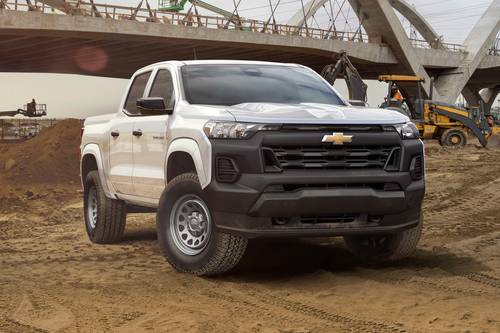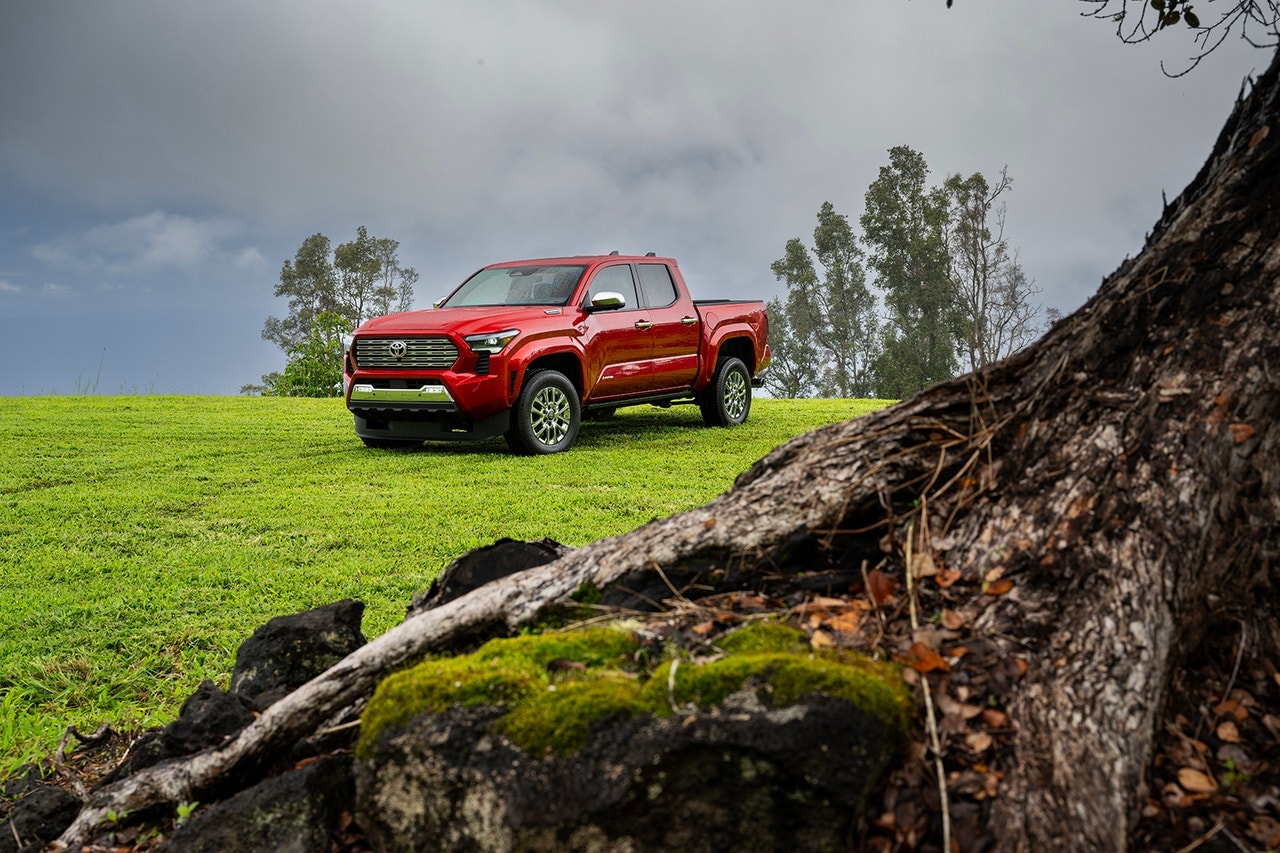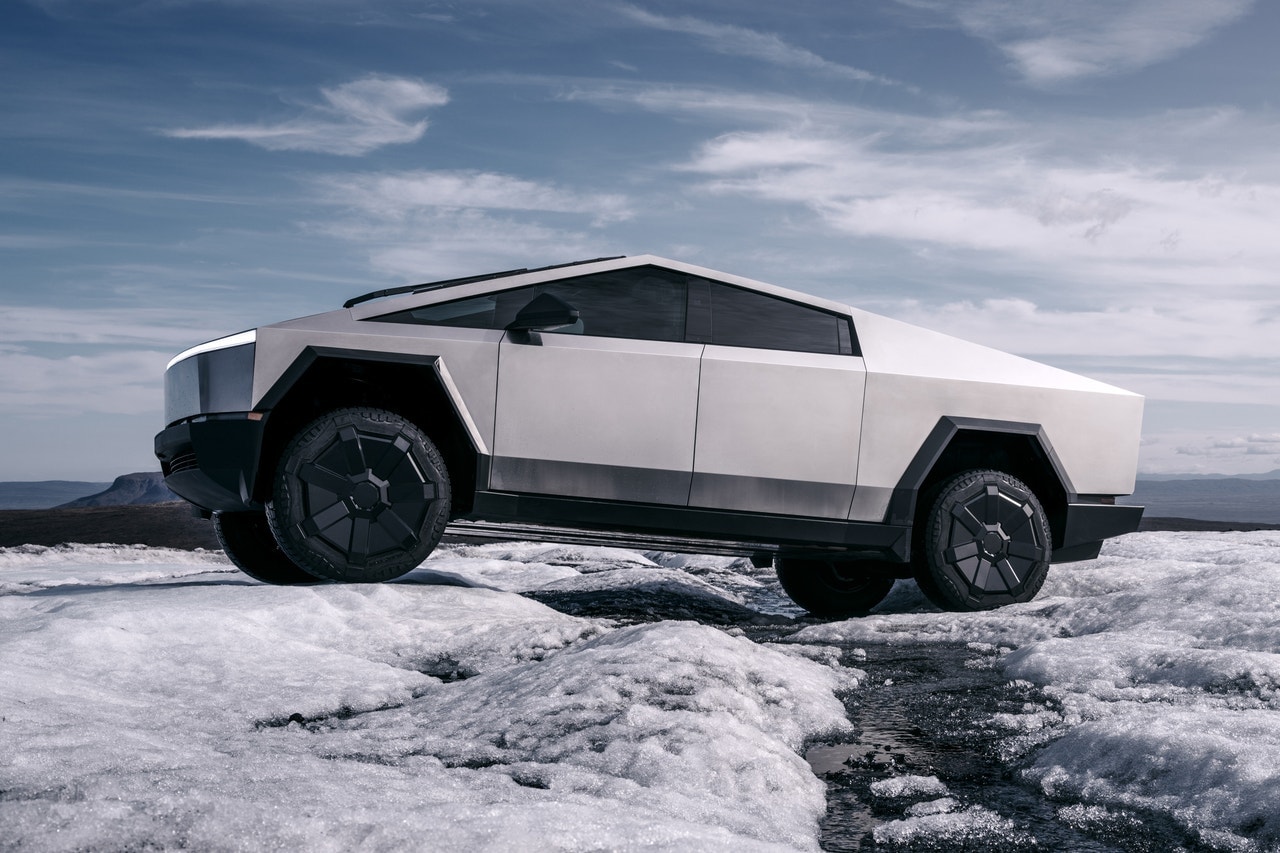Truck Buying Guide
Shopping for a pickup? Whether you're looking for a midsize, full-size or something fully electric, our comprehensive truck buying guide can help. With reviews, ratings, news and videos all in one place, we make it easy to find the truck that’s right for you.
How Much Truck Do I Need?
Research by Truck Type
What Will I Use My Truck For?
Edmunds Rating Spotlight
| Vehicle | 2024 Chevrolet Colorado Work Truck 4dr Crew Cab SB (2.7L 4cyl Turbo 8A) | 2024 Honda Ridgeline Sport 4dr Crew Cab AWD SB (3.5L 6cyl 9A) | 2024 Jeep Gladiator Sport 4dr Crew Cab 4WD SB (3.6L 6cyl 6M) | 2024 Toyota Tacoma SR 2dr Xtracab 6.1 ft. SB (2.4L 4cyl Turbo 8A) |
|---|---|---|---|---|
| Vehicle | ||||
| Photo | ||||
| Section Title | Edmunds Rating | Edmunds Rating | Edmunds Rating | Edmunds Rating |
| Overall Rating | 8.2 /10 | 7.9 /10 | 7.6 /10 | 7.6 /10 |
| Rating breakdown |
|
|
|
|
| Full review |
What’s It Like to Live With?
Edmunds purchases several vehicles each year for the long-term fleet. These vehicles are driven 20,000 miles in the first year of ownership. We report on the red flags, the routine ins and outs, and everything else that car shoppers need to know about the ownership experience.
Truck Videos
Watch Video
All New 2024 Toyota Tacoma vs. 2023 Tacoma
That Much Better? Interior, Powertrain & More
Truck News
Market segment
Edmunds classifies pickups in small, midsize, large and heavy-duty segments. Knowing what you need and what you want in a truck is important if you expect to get the right tool for the job and not pay for more capability than you'll use.
Cab and bed designs
Truck manufacturers often have different names for them, but the three main cab designs are regular cab, extended cab and crew cab. Regular-cab trucks have two doors, seat two or three people, and offer a small amount of in-cab storage.
Extended-cab trucks also have two doors but a larger cab that can seat up to six people. The rear seats — usually just small jump seats — can be cramped for passengers, so the primary benefit of an extended cab is for storing more cargo in the locked, weathertight interior.
Crew-cab trucks have four doors and also seat up to six people, but they offer more generous rear passenger space. Some automakers also offer two sizes of crew-cab designs for their trucks.
Trucks are typically sold with either a short bed or a long bed. There's no standardized measurement tied to each, though most short beds are around 6 feet in length and long beds are around 8 feet. Short beds typically keep the truck's overall length shorter, which helps with maneuverability, while long beds increase cargo space at the expense of either cab space or maneuverability.
Price
The benefit of so many truck configurations is that you can tailor most of them with optional equipment, including everything from luxury amenities to auxiliary lights and accessories. They can be weekday workhorses, weekend adventurers and reflections of your personality every day. On the other hand, while base prices might range from about $23,000 for a basic small truck to $48,000 for a bare-bones heavy-duty crew cab, you can easily spend double those figures for fully loaded models equipped with all of the extras.
Performance and MPG
Modern trucks come with gas, diesel, hybrid or fully electric powertrains. Conventional engines range from four-cylinder to V8 configurations and are typically either turbocharged or naturally aspirated (aka non-turbocharged). Most trucks usually come with at least two engine choices, allowing you to pick one that best suits your needs. You might pick a four-cylinder engine for the best fuel economy, for instance, or a beefy V8 or turbocharged V6 for strong acceleration and towing capability. The optional diesel engines in heavy-duty trucks are specifically designed for towing performance. Electric truck powertrains are a new development, but the few current models offer robust strength and prodigious torque output to handle most truck tasks.
Drivetrain
If you prefer to shift your own gears, a handful of trucks offer a manual transmission, including the latest Toyota Tacoma. But the majority roll out of the factory with an automatic. Nearly all trucks come standard with two-wheel drive (2WD) and offer optional four-wheel drive (4WD). Typically, a 2WD truck can tow and haul more weight, but if you're planning to go off-road, you'll want 4WD.
Some 4WD trucks have a manual two-speed transfer case, while others offer shift-on-the-fly electronic 4WD. The low-range gearing available from a two-speed transfer case can be helpful when off-roading. Automatic 4WD is also available, engaging whenever reduced traction requires it. Limited-slip or locking differentials and driver-selectable electronic presets optimized for terrain and conditions also help maximize off-road traction.
Roominess
A crew cab gives you the most space for people and cargo you'd rather not store in the cargo bed. At a minimum, a regular-cab pickup seats two people, or three if you choose one with a bench-style front seat. Extended cabs have rear jump seats or a small rear bench seat designed to occasionally accommodate passengers. Crew cabs offer expansive rear seating, with the largest trucks offering enough room for tall passengers to stretch their legs and relax.
Towing and payload
Two of the main reasons to buy a pickup truck are towing and hauling capabilities. Across all truck classes, though, the numbers vary, and dramatically so. Broadly speaking, small trucks top out at around 5,000 pounds of maximum towing capacity, while midsize trucks range from around 5,000 to 7,000 pounds. Light-duty full-size trucks max out at around 12,000 to 13,000 pounds.
Heavy-duty trucks, with their more robust construction and available diesel engines, can pull upward of 35,000 pounds depending on model and configuration. Newer electric trucks are limited by battery capacity and range but can still pull around 10,000 pounds, a useful number for many tasks.
Payload capacities — the maximum weight of stuff you can put in the bed — are also highly variable, even within a singular pickup's range of configurations. As with towing capacity, heavy-duty trucks can handle the most payload. Knowing what you expect to do with a truck dictates the right one to serve your needs.
Safety
When it comes to safety, trucks are more sophisticated than ever, available with the latest advanced driver assistance systems and connected services that can provide immediate help when necessary. Numerous trailer-towing features, such as sensors that monitor a trailer's blind spots, also make modern trucks safer to drive. The newest designs also tend to perform well in crash tests conducted by the National Highway Traffic Safety Administration and Insurance Institute for Highway Safety, so be sure to compare safety ratings if this is an important factor in your decision.
Cost to own
The more capable a truck is, the more expensive it will likely be to own. Bigger and more powerful engines typically consume more fuel, and while diesel engine options are efficient, they're usually more expensive up front. 4WD systems and specialty off-road versions also add cost. More expensive trucks also typically cost more to insure.
Compact Truck Guide
If your towing and hauling needs are minimal to modest, or you're on a strict budget, a small pickup might be perfect for you. This is a new class of truck, although reminiscent of a design last seen during the 1980s (search "Subaru BRAT" or "Dodge Rampage" for a sampling). There are only two models to choose from today — the Ford Maverick and the Hyundai Santa Cruz — both characterized by four doors, a small cabin and a short bed. The Maverick and the Santa Cruz are smaller than midsize trucks such as the Ford Ranger and Toyota Tacoma and less capable for towing, hauling and off-roading. The Santa Cruz is a bit more refined and car-like and more suited to active lifestyles, while the Maverick looks and feels more like a micro-truck. Both still offer useful utility, with 4.5-foot beds and up to 4,000 pounds of towing capacity. They're also easy to park and easy on gas thanks to their efficient four-cylinder engines. The Maverick is even available with a hybrid powertrain.
Midsize Truck Guide
Midsize trucks are bigger and more capable than small trucks, with a higher capacity for towing and hauling. A midsize truck typically costs less than a full-size truck, although prices for a mid-trim model can often match the base price of a full-size truck. It really comes down to how much capability you need. Many buyers prefer a midsize truck for the smaller footprint and ease of maneuvering and parking. If you're looking for a Goldilocks kind of truck, it could well be a midsizer.
There are several choices. The recently redesigned Chevrolet Colorado and GMC Canyon models (both nearly mechanically identical) combine workhorse utility with modern cabin and safety tech, improved fuel efficiency and more towing power. The new Toyota Tacoma, meanwhile, is an impressive overhaul of what many consider the benchmark of midsize trucks. Changes include updated tech, a more comfortable interior, innovative off-road features and a hybrid engine.
The Nissan Frontier, also recently redesigned, is similarly capable in towing and hauling, and it's generally more affordable than its rivals. Not to be outdone, a redesigned Ford Ranger is on the way with an updated engine lineup and broad tech upgrades that include trailer assist features. Off-road enthusiasts will also find much to like in the dedicated trail models within the Colorado, Frontier, Ranger and Tacoma lineups.
For a truly focused off-road experience, the Jeep Gladiator stands out with its powerful optional diesel engine, removable top and doors, and legendary Jeep hardware for conquering trails that cause other trucks to turn back.
If you're seeking a well-rounded truck that drives with the ease of a car, you'll like the Honda Ridgeline. Based on an SUV-style chassis, the Ridgeline can't tow or haul as much as other midsize trucks. But it compensates with a comfortable ride, effortless steering, clever storage features and a useful 5.3-foot bed.
With all of the changes, upgrades and improvements in this segment, there's never been a better time to shop for a midsize truck.
Full-Size Truck Guide
Full-size trucks split into two camps: Light-duty and heavy-duty.
Your neighbor probably owns a light-duty truck since they're among the top-selling vehicles in America, and they offer a timeless mix of value, capability and equipment. Heavy-duty models are more specialized workhorses, required when you expect to tow and haul heavy loads. If your neighbor builds houses or tows a massive travel trailer, it's probably a heavy-duty in the driveway.
Among light-duty trucks, the Ram 1500 is a standout. It offers the smoothest ride in the class and expertly mixes rugged capability with an upscale interior. Ram also offers the TRX, a supercharged off-road performance truck.
Another top pick is the F-150, which can be configured as a basic work truck, a luxurious toy hauler, an extreme off-road machine, or almost anything in between. It offers a half-dozen engine choices, including a hybrid V6, and the most towing and hauling capacity of today's light-duty pickups. The F-150's sheer versatility makes it one of our favorites.
The Chevrolet Silverado 1500 holds its own with a wide mix of engines and configurations, and the mechanically related GMC Sierra 1500 Denali sets the standard for pickup truck luxury with its chrome-encrusted exterior and opulent cabin.
The recently redesigned Toyota Tundra is a legitimate alternative to the American truck brands. The new Tundra has fresh, rugged style, a turbo V6 with more power and better fuel economy than the former V8, and updated comfort and tech. The Nissan Titan is another option, although it's limited to a single V8 engine with fewer trim levels and less capability than its competitors. It does offer a generous warranty, however.
Heavy-duty trucks are up for nearly any task: If you need to haul earth, rock or building materials, or tow horse trailers, fifth-wheel campers or even other trucks, you'll need an HD pickup. The maximum capabilities of heavy-dutys are pretty evenly matched, and the differences between models are not as significant as those between midsize or light-duty full-size pickups. The main factors typically involve engine type (gas or diesel), towing receiver (gooseneck or tongue hitch), bed length, wheel size and axle ratios, among other details.
When picking from the current crop of heavy-duty trucks, which include the Chevrolet Silverado HD, GMC Sierra HD, Ford Super Duty and Ram Heavy Duty lineups, it's best to look for the features and technology that help you get the job done rather than the official maximum towing and payload ratings. Preferred styling and interior comfort play a role here too.
The Nissan Titan XD is an alternative for some buyers. The Titan XD sits between light- and heavy-duty capabilities, offering the comfortable ride and road manners of the former with the extra muscle of the latter. The XD hasn't been updated for several years, however, and most light-duty trucks now eclipse its tow ratings. The Titan XD doesn't cost quite as much as other heavy-duty trucks, though, so it could be an option if your trailering needs aren't extreme.
Electric Truck Guide
Love it or loathe it, the EV revolution has come for trucks. And while many people think of electric vehicles as either shapeless, soulless transportation pods or Teslas, the pairing of trucks and electricity isn't as strange as it sounds. Electric motors make mountains of torque, and torque is the currency of modern-day trucks. EVs can also deliver most of that torque instantly, unlike even the stoutest gas or diesel engines whose grunt is mediated by transmissions, driveshafts, axles and often turbochargers.
Today there are only three EV trucks in mainstream production: the Ford F-150 Lightning, the Rivian R1T and the GMC Hummer EV. Like the gas-powered F-150, the Lightning is built on a robust truck frame and is capable of full-size truck tasks. Towing capacity is limited to a still useful 10,000 pounds and range is estimated at 320 miles on a full battery charge (although we've achieved up to 345 miles in Edmunds' testing). The Lightning also has enough capacity to run power tools and electronic devices and even send current to power your home.
The GMC Hummer EV is likewise built on a tough truck frame, but it takes luxury, off-road capability and pricing to extremes. It offers 329 miles of range, all manner of off-road tech tricks, and a nifty CrabWalk feature, which points the front and rear wheels in the same direction for sideways and diagonal movements. The Hummer EV is also exceedingly heavy, tows just 7,500 pounds and costs six figures. Though it's impractical for most buyers, the Hummer EV offers glimpses of innovations we can expect to see in future GMC and Chevy EVs.
Finally, the Rivian R1T blends performance, comfort, utility and capability into an intoxicating adventure mobile. It accelerates like an elite sports car, can tow up to 11,000 pounds, and will do about 315 miles on a full charge with its Large battery pack. Sized between a midsize and full-size truck, the R1T has some clever storage solutions, including a front trunk (the F-150 has one, too) that complements the short 4.5-foot cargo bed.
Other EV trucks are on the way. The Chevrolet Silverado EV is essentially a Chevy version of the Hummer EV with less extreme features and an ambitious target of a 20,000-pound maximum towing capacity. GMC will also launch its own Sierra-branded version of the Hummer package. The Ram 1500 REV is expected as a 2025 model, promising up to 14,000 pounds of towing capacity and 500 miles of maximum range. The much-teased Tesla Cybertruck could arrive as early as fall 2023, with its sci-fi style and oddball utility, and there are at least a half-dozen other EV-truck startups — Alpha, Lordstown, Atlis, etc. — that could be fighting for the affections of truck buyers in the next three to five years.
Edmunds says
Choosing the right pickup truck isn't easy. The endless combinations of cab styles, drivetrains, trim levels and optional equipment can prove daunting. The key is identifying which size and class of truck suits your needs, then determining which models fit your budget. From there, it's a matter of choosing the design and equipment that most appeals to you, then finding that truck in dealership inventory or custom-ordering exactly what you want. At Edmunds, we're ready to assist you every step of the way.





















